
* In 1965, the Dassault firm introduced their first business jet, the "Falcon 20", with twin rear-mounted turbofans. It proved successful, leading in the 1970s to the scaled-down "Falcon 10" twinjet, and the larger "Falcon 50" tri-jet -- with the Falcon 50 leading in the 1980s to the still larger "Falcon 900" tri-jet. They sold well, primarily as civil executive transports, but also for a number of military special-mission roles.
* In the postwar period, executive aircraft were typically piston twins, often refurbished military aircraft left over from the conflict. With the jet engine coming of age in the 1950s, by the end of that decade, there was an urge to bring executive aviation up to date. Military forces were also interested in obtaining jet aircraft for the liaison, utility, electronic services, and crew training roles.
Following preliminary studies in late 1961 Marcel Dassault, head of the French Dassault Aviation firm, formally initiated development of an eight / ten-seat executive jet / liaison aircraft, with Sud Aviation -- later Aerospatiale -- being a partner in the program, obtaining a share in manufacturing. The prototype of the "Mystere 20" performed its initial flight in at Bordeaux-Merignac on 4 May 1963. It made a public appearance at the Paris Air Show later that year.
The configuration of the Mystere 20 was representative of the future of executive jet aircraft: an all-metal aircraft with low wings, all-swept flight surfaces, tricycle landing gear, and a jet engine mounted on each side of the rear fuselage. The original powerplants were Pratt & Whitney (PW) JT12A-6 turbojets with 14.6 kN (1,495 kgp / 3,300 lbf) thrust each. In consequence of discussions with Pan American Airlines, the prototype was re-engined with twin General Electric (GE) CF700 rear-fan turbofans. The Mystere 20 performed its first flight with the new engines on 10 July 1964. The prototype eventually made its way to the Air & Space Museum at the Le Bourget airport near Paris.
The first production Mystere 20 performed its initial flight on 1 January 1965, with both French and US certification awarded in June 1965. Later that year, the second production machine established several performance records for its class.
Pan Am had signed a contract with Dassault to distribute the Mystere 20 in the Western Hemisphere, with the deliveries then beginning to a Pan Am outfitting facility in Burbank, California -- aircraft for the rest of the world were flown out of Bordeaux-Merignac. From 1966, American-delivered Mystere 20s were sold as the "Fan Jet Falcon", this later evolving into "Falcon 20". Since the "Mystere" name for this aircraft series would eventually be dropped, the name "Falcon" is generally used here.
* The initial production "Falcon 20C" provides a baseline for the series. It was of all-metal construction, mostly aircraft aluminum alloy. The wings had a sweepback of 30 degrees at quarter-chord; there was a two-segment single slotted flap inboard and an aileron outboard on each wing; a wing fence about 40% of the span from the fuselage; a leading-edge flap outboard of the fence; and a two-segment spoiler / lift dumper behind the fence. The production machine was 46 centimeters (18 inches) longer than the initial prototype, and had a wingspan 100 centimeters (40 inches) wider.
All the wing control surfaces were hydraulically driven; rudder and elevators were also hydraulically driven. The tailplane, which featured electrically-driven variable incidence, was mid-mounted on the tailfin. The wings and the engine intakes were de-iced by engine bleed air.
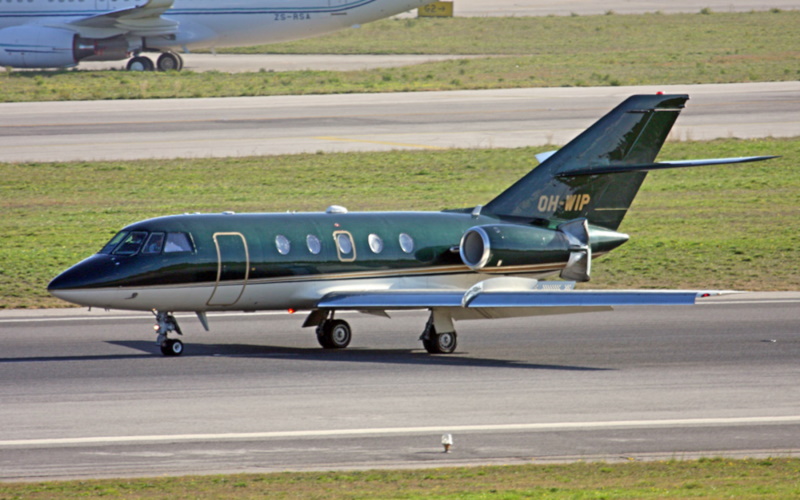
The Falcon 20C was powered by CF700-2C turbofans -- hence the "20C" designation of the aircraft -- with 18.3 kN (1,870 kgp / 4,125 lbf) thrust each. There was an integral fuel tank in each wing; sources also mention twin auxiliary tanks in the rear fuselage, but specifics are unclear. The fuel systems were independent for each engine, though there was a cross-feed capability.
All three gear assemblies had dual wheels, all being hydraulically actuated, the main gear retracting inward towards the fuselage, the steerable nose gear retracting forward. They had disk brakes and an antiskid system. The initial prototype had featured single wheels. Sources claim that a brake chute was standard, but it is unclear if many users took advantage of that feature.
In an executive jet configuration, there were eight passenger seats; high-density configurations included 8 to 14 seats. There was a toilet in the rear, a buffet with refrigerator up front, and baggage / wardrobe space front and rear. Accommodations were pressurized and climate-controlled. There were four vertical-oval passenger windows on each side of the fuselage; there was a downward-folding "airstair" door on the front left of the fuselage, and an emergency exit over each wing.
A "quick-change" kit was eventually offered to permit a Falcon to be rapidly converted from passenger to freight carriage, and back again; there being no freight door, it appears the cargo capability was for parcels and other items that could be hand-loaded. Falcons have also been used as airline crew trainers, radio navigation systems calibration platforms, and photographic geophysical survey. Avionics were typical for a jetliner of the era: flight instrumentation, radios, navigation gear, ATC transponder, with weather radar being optional.
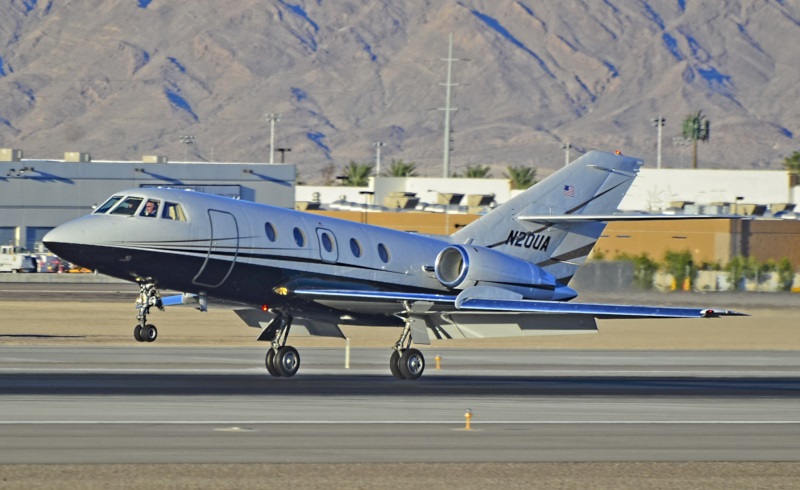
Some sources seem to hint that there was a "Falcon 20" variant that preceded the Falcon 20C, but supposedly it only differed in having a smaller fuel supply, and it is unclear if any of such "Falcon 20" machines were built. A single Falcon 20C was modified to a rough-field configuration, the "Falcon 20CC" -- it seems for "cross-country" or the like -- for an Australian customer. It featured low-pressure tires, no main gear doors, and a reinforced belly to deal with gravel kicked up by the landing gear.
The Falcon 20C was followed by improved variants:
___________________________________________________________________
DASSAULT FALCON 20F:
___________________________________________________________________
wingspan:
16.3 meters (53 feet 6 inches)
wing area:
41 sq_meters (440 sq_feet)
length:
17.15 meters (56 feet 3 inches)
height:
5.32 meters (17 feet 7 inches)
empty weight:
7,530 kilograms (16,600 pounds)
MTO weight:
13,000 kilograms (28,660 pounds)
max cruise speed:
865 KPH (465 MPH / 405 KT)
service ceiling:
12,800 meters (42,000 feet)
range:
3,347 kilometers (2,080 MI / 1,810 NMI)
___________________________________________________________________
From the early 1970s, a number of Falcon 20s were converted by Little Rock Airmotive -- of Little Rock, Arkansas -- to "Falcon Cargo Jet" AKA "Falcon 20DC" cargo haulers for Federal Express, featuring a hydraulically-actuated, top-hinged cargo door on the left forward fuselage, the door being 1.88 meters wide and 1.44 meters high (6 feet 2 inches by 4 feet 9 inches). An aluminum cargo floor was fitted, the floor being flush with the bottom of the door, and featuring a large number of tie-down points. Floor-mounted rollers were optional; avionics were generally modernized. An electronic system to automatically measure cargo weight and distribution was installed.

In 1973, one of these cargo Falcons flew the very first Fedex air delivery flight, this machine later becoming a prominent exhibit at the Smithsonian's Udvar-Hazy Center at Dulles Airport in Virginia. At the peak, Fedex operated 33 Falcon 20s -- though the type was eventually retired in favor of larger and more cost-effective aircraft, as Fedex business grew. Other firms later offered cargo conversions of the Falcon 20.
A number of Falcons were updated with Garrett TFE731-5AR-2C or TFE731-5BR-2C turbofans, along with modification of bleed air, anti-ice, hydraulic, fuel, electrical and engine control systems, plus installation of an automatic take-off thrust control system (ATTCS). These "Falcon 731" conversions were redesignated "Falcon 20C-5", "Falcon 20D-5", "Falcon 20E-5", and "Falcon 20F-5". There was also an effort to re-engine Falcon 20s with Pratt & Whitney Canada PW305 turbofans, but it never actually happened.
* The last production variant in the Falcon 20 series was the "Falcon 200", originally designated "Falcon 20H" -- as a commercial follow-on to the militarized "Falcon 20G", discussed below. The Falcon 200 was generally improved, most significantly featuring Garrett ATF3-6A-4C turbofan engines with 23.2 kN (2,360 kgp / 5,200 lbf) thrust each. It also had a larger fuel supply. It was used in much the same roles as the original Falcon 20 series -- executive transport; radio navigation systems calibration; and quick-change cargo carriage, with some converted to a pure cargo configuration, like the FedEx Falcon 20s.
The Falcon 200 remained in production to 1988. At end of production, a total of 473 Falcon 20s and 35 Falcon 200s, including military machines, had been manufactured. The type remains in extensive service, though machines still flying had to have hushkits installed to keep their noise levels down. Other update options are available, most notably glass cockpit schemes.
BACK_TO_TOP* The story of the militarized Falcon 20G began in 1976, with Dassault promoting an upgrade program to refit existing Falcon 20s with ATF3-6-2C turbofans, the suggestion being that the company would eventually produce a Falcon 20G with those engines. The US Coast Guard (USCG) then announced a competition for a "Medium Range Surveillance (MRS)" aircraft; Dassault, through the US Falcon Jet operation, submitted the Falcon G, modified to meet the USCG spec, and won the contract, which was for 41 aircraft. Dassault abandoned the re-engining effort to focus on delivering the USCG machines.
The first "HU-25A Guardian", as it was designated by the USCG, flew in 1977, with 41 delivered in 1982:1983. The HU-25A / Falcon 20G was much like the earlier Falcon 20F, most significantly differing in being fitted with Garrett AiResearch ATF3-6-2C turbofans, with 24.65 kN (kgp 2,510 kgp / 5,538 lbf) thrust each; and featuring fuel capacity raised to 5,700 liters (1,524 US gallons).

The Guardian featured a large window mounted forward on each side of the fuselage for search with binoculars, cameras, or handheld night imagers on each side of the forward fuselage; they had military communications and navigation kit plus a weather / search radar in the nose, but apparently no other sensors, at least as delivered. There were four stores hardpoints under the fuselage and two stores hardpoints under each wing. There was a hatch in the bottom of the forward cabin, with a roller track to permit paradropping of rescue stores. The baseline Guardian was subsequently updated into a series of variants:
HU-25s performed patrol duty in the battle theater during the First Gulf War. The HU-25 was retired from USCG service in 2014, being replaced by the twin-turboprop HC-144 Ocean Sentry, a maritime patrol version of the Airbus CN-235. One of the retired Guardians was passed on to the US National Aeronautics & Space Administration, being fitted with a precision laser altimeter for Antarctic surveys.
The French Air Force obtained a number of Falcon 20s as crew trainers, these "Falcon ST" aircraft being fitted with the combat avionics of various Dassault Mirage combat aircraft. Falcon 20s were also used as radar and other systems trials platforms by the French Centre d'Essais en Vol (CEV). In some cases, apparently the CEV trials machines went on to become systems trainers. At least one was used by the French as a target tow tug, with a tow winch on a pylon under each wing.
Five Falcon 200s were acquired by the French Aeronavale in a configuration like that of the HU-25 -- with the big observation windows and militarized avionics -- to be named the "Gardian". They have been used for ocean patrol around French possessions in the Pacific; they are now being phased out. Dassault attempted to push a simplified version, the "Gardian 2", for the export market; it seems two were bought by Chile, these machines having been photographed armed with Exocet antiship missiles.
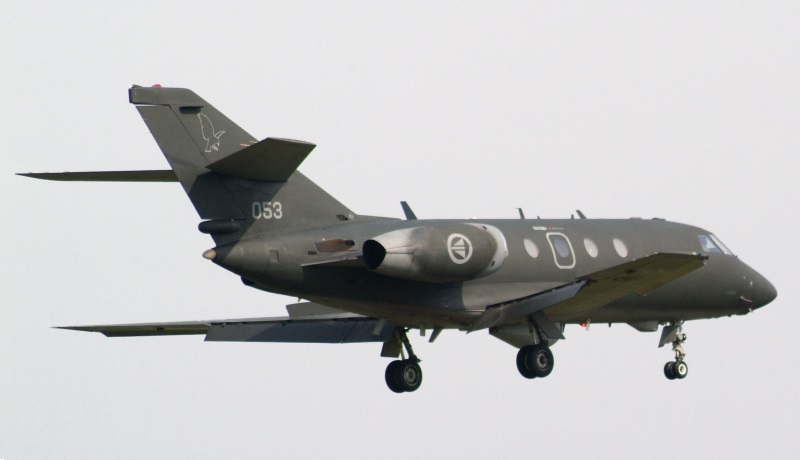
The Falcon 20/200 was also used in military, or military support, roles by a number of other nations:
For want of a better place to mention it, Canada's National Research Council operates a Falcon 20 for zero-gravity studies, the aircraft flying to height and then dropping in a parabolic arc. Incidentally, for obvious reasons such machines are known as "vomit comets".
BACK_TO_TOP* The Falcon 20 proving successful, Dassault decided to build a 70%-scale executive jet along the same lines, originally naming it the "Minifalcon". It emerged as the "Mystere / Falcon 10", the first of three prototypes making its initial flight on 1 December 1970. It proved to have excellent performance, with the prototypes setting records in their class. The type entered service in 1973.
The Falcon 10 was a new-design aircraft, having little or no parts compatibility with the Falcon 20. General configuration was like that of the Falcon 20, with a low-mounted wing, all-swept flight surfaces, an engine on each side of the rear fuselage, and tricycle landing gear. Flight control surface arrangement was similar, though the wing fence was shorter, full-span leading-edge slats were fitted, and there were double slotted flaps. Each wing had a slightly steeper sweep out to the fence. There were two hardpoints under each wing for external stores carriage.
The Falcon 10 was powered by twin Garrett TFE731-2 turbofans with 14.65 kN (1,464 kgp / 3,230 lbf) thrust. The initial powerplant for the first prototype was the GE CJ610, with the other two prototypes fitted with the Garrett turbofans from the outset. The fuel system was much like that of the Falcon 20, with an integral fuel tank in each wing and twin auxiliary tanks in the rear fuselage. Each engine had its own fuel system, but the two fuel systems had a crossfeed mechanism; there was single-point refueling. Total fuel capacity was 3,440 liters (882 US gallons).

Landing gear arrangement was much like that of the Falcon 20, except the nose gear had a single wheel. The Falcon 10 had four passenger seats in a luxury configuration, up to a maximum of seven passenger seats in a high-density configuration. There were three windows on each side of the fuselage, with a split door on the front left side of the fuselage, the lower half of the door featuring an airstair. Avionics were conventional for the era, with instrumentation, radios, radio navigation aids, and ATC transponder. Weather radar was optional.
___________________________________________________________________
DASSAULT FALCON 10:
___________________________________________________________________
wingspan:
13.08 meters (42 feet 11 inches)
wing area:
24.1 sq_meters (259 sq_feet)
length:
13.85 meters (45 feet 5 inches)
height:
4.61 meters (15 feet 2 inches)
empty weight:
4,880 kilograms (10,760 pounds)
MTO weight:
8,500 kilograms (18,740 pounds)
max cruise speed:
915 KPH (568 MPH / X KT)
service ceiling:
13,720 meters (45,000 feet)
range:
3,555 kilometers (2,210 MI / 1,920 NMI)
___________________________________________________________________
The Falcon 10 could also be kitted up for roles such as aerial photographic survey, air ambulance, and radio system calibration duties. The type's performance was excellent, the Falcon 10 setting speed records for its class.
A "Falcon 10MER" version was built, with seven sold to the Aeronavale, the French naval air arm. It had no significant military optimizations, being used for liaison and training. It has been upgraded in service with new avionics, and there are no plans for retirement at last notice.
A single "Falcon V10F", presumably modified from a stock Falcon 10, with carbon-composite wings, as part of an experimental program sponsored by the French government. After trials, it was actually put into commercial service, though it was the only Falcon 10 to have composite wings. Dassault would use the technology in later members of the family.

189 Falcon 10s were built. In 1983, production switched to the "Falcon 100" variant, with greater take-off weight, an extra passenger window on the right side of the fuselage opposite the door, a larger luggage compartment, and glass cockpit, with 37 built to end of production in 1989 -- for a total of 189 + 37 == 226 Falcon 10/100 jets in all. At last notice, the type was still lingering in service.
BACK_TO_TOP* While Dassault was getting the Falcon 20 out the door, the company was also considering a stretched jetliner derivative. The project remained on the back-burner for several years, to eventually evolve into a new-design aircraft, with development of the "Mystere / Falcon 30" being finally initiated in late 1967. The prototype, powered by twin Lycoming ALF 502D turbofans, performed its initial flight at Merignac on 11 May 1973, aircrew being Jean Coureau and Jerome Resal. It was displayed at the Paris Air Show later in that month.
Along with the 30-seat Mystere / Falcon 30, a 40-seat "Mystere / Falcon 40" -- with a revised wing and reduced range -- was envisioned. Although orders were taken, economic circumstances coupled to the oil crisis of the time led to the cancellation of the Falcon 30 project in 1975. The Falcon 30 failing, Dassault did move on to a tri-jet follow-on to the Falcon 20, the "Mystere / Falcon 50", with the first of three "Falcon 50" prototypes performing its initial flight on 7 November 1976. Certification was awarded in 1979, with customer deliveries following.
The Falcon 50 was made primarily of aircraft aluminum alloy. It featured a low wing, all-swept flight surfaces, and tricycle landing gear. It clearly showed its origins in the Falcon 20, having the same general arrangement and the same fuselage diameter. It differed significantly in having a new wing, plus of course the third engine, fed by an S-duct with the intake at the base of the tailfin. Its primary selling point was its long range, which was unprecedented for a production business jet.
The wing had compound sweep, with the inboard section featuring steeper sweep than the outboard. Each wing had full-span leading-edge slats -- plus four-section double slotted flaps inboard, an aileron outboard, and triple airbrakes / lift dumpers ahead of the flaps. The tailplane had elevators and variable incidence, while the tailplane had a one-piece rudder. All flight controls were hydraulically actuated.
Engines were Honeywell TFE731-3 turbofans, with a take-off rating of 16.5 kN (1,680 kgp / 3,700 lbf) thrust each; the center engine had a thrust reverser. There were fuel tanks in the wings and the fuselage, with single-point refueling, total fuel capacity being 8,765 liters (2,315 US gallons). A Garrett auxiliary power unit (APU) turbine was available as an option. All landing gear assemblies had twin wheels, and were hydraulically retracted; the steerable nose gear retracted forward, while the main gear pivoted from the wings in towards the fuselage.
There were two aircrew, with an auxiliary seat behind the copilot. Standard avionics included weather radar and long-range navigation gear, such as an Omega receiver; later production had a Honeywell electronic flight instrumentation system (EFIS) in the cockpit.
Accommodations could feature a crew toilet, wardrobe, and galley forward in the front of the cabin, and a toilet in the back, with executive / VIP accommodations for up to eight or nine passengers; alternatively, deleting the rear toilet made space for twelve passengers. Since the Falcon 50 was a long-range luxury jet, it was typically flown with small passenger loads. Accommodations were pressurized and climate-conditioned. There was a pressurized baggage hold in the rear, with a loading door on the left side of the fuselage. There were seven vertical-oval passenger windows on each side of the fuselage, plus a fold-down airstair door on the forward left fuselage, and emergency exits over each wing.

An improved version of the Falcon 50, the "Falcon 50EX", was introduced in 1997, replacing the Falcon 50 in production. The Falcon 50EX was fitted with Honeywell TFE731-40 turbofans with 16.46 kN (1680 kgp / 3,700 lbf) thrust each and better specific fuel consumption, improving range. It also featured updated avionics, the APU included as standard, and various minor tweaks. A Falcon 50 was modified as the prototype, with a hundred Falcon 50EX machines built to end of production in 2008.
Total production of the Falcon 50 and Falcon 50EX was 352 machines. Civil Falcon 50-series machines still remain in extensive service, with upgrades such as winglets and modernized glass cockpits available.
___________________________________________________________________
DASSAULT FALCON 50EX:
___________________________________________________________________
wingspan:
18.86 meters (61 feet 10 inches)
wing area:
46.83 sq_meters (504.1 sq_feet)
length:
18.52 meters (60 feet 9 inches)
height:
6.98 meters (22 feet 11 inches)
empty weight:
9,890 kilograms (21,800 pounds)
MTO weight:
18,010 kilograms (39,700 pounds)
max speed:
1,015 KPH (630 MPH / 550 KT)
cruise speed:
905 KPH (560 MPH / 490 KT)
take-off distance:
1,490 meters (4,890 feet)
landing distance:
890 meters (2,920 feet)
service ceiling:
14,936 meters (49,000 feet)
range:
5,695 kilometers (3,537 MI / 3,075 NMI)
___________________________________________________________________
Falcon 50 production included machines acquired as VIP transports by a number of governments, including France, Germany, Iraq, Jordan, Libya, Morocco, South Africa, Spain, and Yugoslavia. As with the Falcon 20, Dassault also promoted the Falcon 50 for maritime patrol or environmental protection patrols. The militarized Falcon 50 was labeled the "Gardian 50", with much the same enhancements as the Gardian 20 maritime patrollers.
The Aeronavale liked the Gardian 50 concept, and so acquired four used Falcon 50s, to fit them with large observation windows on each side of the forward fuselage; a hatch with a windblast deflector under the forward belly for paradropping rescue kit; a Thales Ocean Master 100 radar in the nose; a FLIR turret, retracting into the rear belly; plus militarized radios.
The first modified "Falcon 50M" machine performed its initial flight in 1999, with introduction to Aeronavale service in 2001. They have since been given various upgrades, including an integrated mission system and an Automatic Identification System (AIS) unit, AIS being an identification / tracking system for ships. The mission system allowed the imager turret to be automatically focused on a radar target, and provided comprehensive identification of targets on the radar display via target IFF.
The Falcon 50M worked out well, the type having excellent performance and endurance, and easy to keep flying; the fact they were pretty helped, too. As a result, four Falcon 50s being retired from French government VIP service were kitted up to a similar configuration, though the belly hatch wasn't implemented; the first went into service in its new role in 2014.
The original four were then designated "Falcon 50Mi" -- for "Maritime Intervention" -- with the second four being designated "Falcon 50Ms" -- for "Maritime surveillance", since they lacked a rescue capability. The fleet was gradually brought up to a common avionics configuration, including a new FLIR turret. The Falcon 50Ms machines were given a belly hatch as well, with the upgrades completed in 2020.
Nobody else obtained a Falcon 50-based maritime patrol configuration. Dassault also promoted a signals intelligence (SIGINT) configuration, but it doesn't appear anyone bought it. There are unconfirmed rumors that, during the Iran-Iraq War of the 1980s, the Iraqis kitted up a Falcon 50 to carry two Exocet antiship missiles.
BACK_TO_TOP* The Falcon 50 led to the "Falcon 900", with initial flight on 21 September 1984, and introduction to service in 1986. It had the same overall configuration as the Falcon 50 -- but was bigger and "fatter", with about 11% greater empty weight, plus a cabin 2.34 meters (7 feet 8 inches) wide and 11.9 meters (39 feet) long. In contrast, the cabin for the Falcon 50 was 1.86 meters (6 feet 1 inch) wide and 7.16 meters (5 feet 10 inches) long.
Like the Falcon 50, the Falcon 900 was a low-wing executive tri-jet, with all-swept flight surfaces, the wing having compound sweep, and tricycle landing gear featuring dual wheels on all gear assemblies. It did have greater use of composite assemblies, and the flaps had two segments, not three.
The baseline production aircraft was powered by three 20 kN (2,040 kgp / 4,500 lbf) Garrett TFE731-5AR-1C turbofan engines, featuring a more efficient "mixer compound" exhaust. It also had a Honeywell APU as standard. There were five fuel tanks -- an integral fuel tank in each wing, a center-section fuel tank, and underfloor fuselage fuel tanks fore and aft -- with total capacity being 10,825 liters (2,860 US gallons). The fuel system featured single-point refueling.
Typical configuration was galley forward, toilet in the rear, with luxury accommodations for eight passengers. Other configurations were possible, up to 19 airliner seats in a high-density configuration. Door arrangement was as for the Falcon 50, but there were 12 windows on each side.
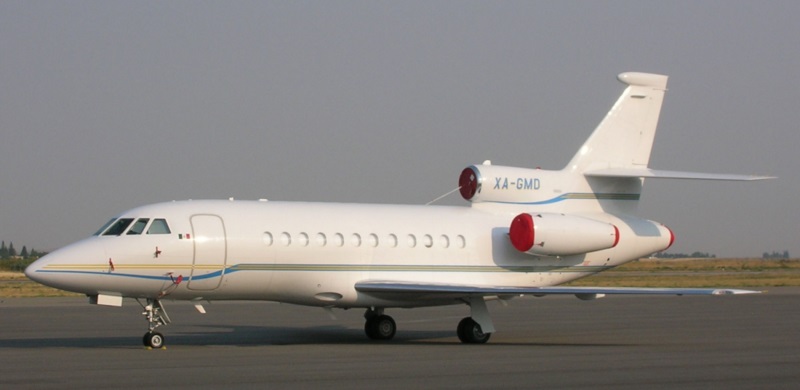
While the Falcon 900 was expensive, its long range, good performance, and luxury accommodations made it worth the money to many buyers. The improved "Falcon 900B" was introduced in 1991, the primary change being TFE731-5BR-1C turbofans, providing 21.13 kN (2,155 kgp / 4,750 lbf) thrust and still longer range.
___________________________________________________________________
DASSAULT FALCON 900B:
___________________________________________________________________
wingspan:
19.33 meters (63 feet 5 inches)
wing area:
49 sq_meters (527 sq_feet)
length:
20.21 meters (66 feet 4 inches)
height:
7.55 meters (24 feet 10 inches)
empty weight:
10,255 kilograms (22,608 pounds)
MTO weight:
20,640 kilograms (45,505 pounds)
max speed at altitude:
925 KPH (575 MPH / 500 KT)
service ceiling:
15,500 meters (51,000 feet)
range:
7,400 kilometers (4,600 MI / 3,995 NMI)
___________________________________________________________________
Further improved variants followed:
Modern Falcon production often has a noticeable bullet fairing on the tip of the tailfin, for a satcom antenna. It is unclear when this option was introduced into production, and if any early production has been refitted with it.
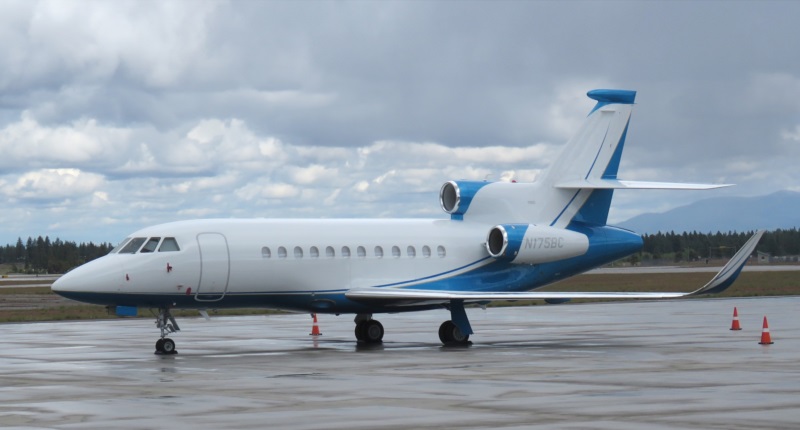
The Falcon 900 is used by the French Escadron de Transport, d'Entrainement et de Calibration, which is in charge of transportation for officials of the French state. The Italian military also flies the type for VIP use as the "VC-900", while the British obtained two 900LX machines for the Royal Flight of the Royal Air Force, which supports the royal family and senior government ministers.
Two examples of a maritime patrol version, the "Falcon 900 MSA", were obtained by the Japan Coast Guard. The MSA featured a search radar, a large rectangular observation window on each side of the forward fuselage, and a hatch for dropping rescue stores.
BACK_TO_TOP